Posts by Ian Glen
Her Majesty Queen Elizabeth II (1926 – 2022) – a Life in Coins
The crown jewels, the palaces, the ceremonial role… Many things represent the role of the monarchy. But nothing has made Queen Elizabeth II more familiar to her subjects than coins.
There are 29 billion individual coins in circulation in the UK. In shops, in banks, and in our pockets… each carrying an image of Her Majesty that will forever be etched in our memories and will live on for years to come in our coinage.
Simply no other element of daily life has done more to link us with our beloved Queen and now we look back on her reign through those very coins.
70 Years – 5 iconic portraits
The Young Queen | 1953 – 67: Mary Gillick
The first coins of Queen Elizabeth’s reign bore Mary Gillick’s portrait of the young Queen, engraved especially for the new coins. The uncrowned portrait of the Queen is still used on the Maundy Money distributed each year by Her Majesty.
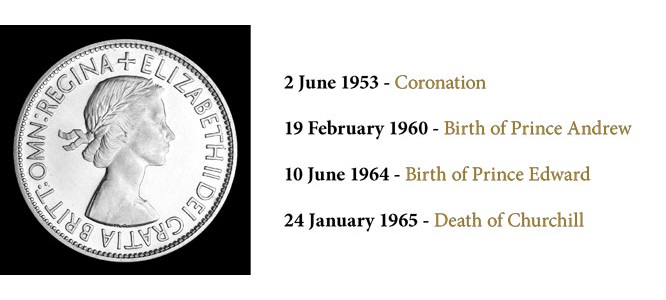
The “Decimal Queen” | 1968 – 84: Arnold Machin RA
With the upcoming decimalisation, it was decided to refresh the Queen’s portrait with Arnold Machin’s new sculpture of the Queen. Commissioned in 1964, it first appeared in 1968 on the new 5p and 10p coins. A version of the design with tiara was also introduced on stamps in 1967 and remains to this day.
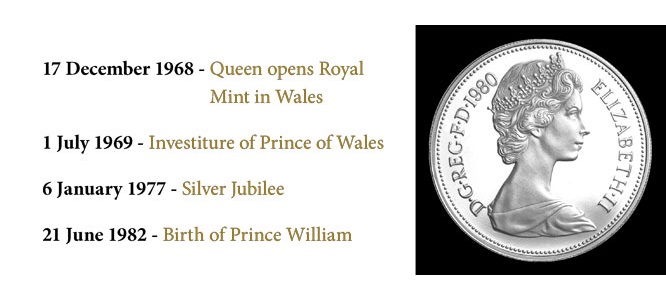
The Grandmother | 1985 – 97: Raphael Maklouf
In creating his new effigy of Her Majesty, which coincided with the Queen’s early years as a grandmother, Raphael Maklouf aimed “to create a symbol, regal and ageless”. His “couped” portrait depicts Queen Elizabeth II wearing the royal diadem favoured by her on the way to and from the State Opening of Parliament.
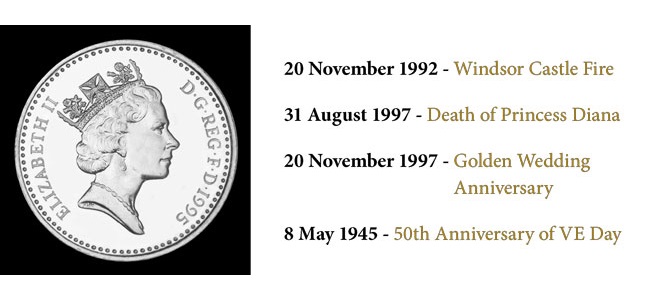
Millennium Queen | 1998 – 2014: Ian Rank-Broadley FRBS
The approaching Millennium saw a fourth effigy on our coinage, designed by Ian Rank-Broadley. Created to fill the full circle of the coin, its larger size was a deliberate response to the smaller 5p and 10p coins in circulation. A noticeably more mature portrayal of Her Majesty, Rank-Broadley aimed to show the Queen with “poise and bearing”.
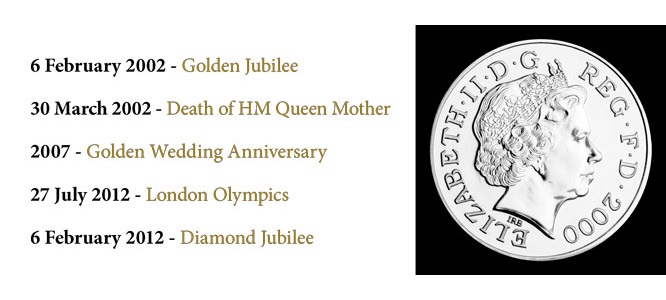
The Longest Reigning Monarch | 2015 – 2022: Jody Clark
The final portrait of Her Majesty was introduced in 2015, the year that the Queen passed Victoria as our longest reigning monarch. It is, of course, that design that will continue to remind us of Her Majesty Queen Elizabeth II for years to come as her old currency continues to circulate long after her death.
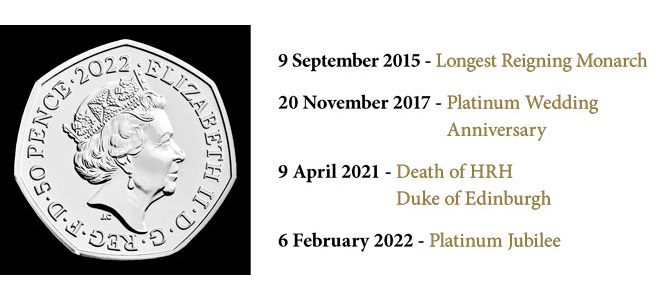
From Coronation to Platinum Jubilee
However, it is perhaps not any of the five main portraits of Her Majesty that represent the Queen’s reign the best, but two special obverse designs. The first goes back to the very first coin released for Queen Elizabeth II – her Coronation Crown. The second, from this year’s Platinum Jubilee.
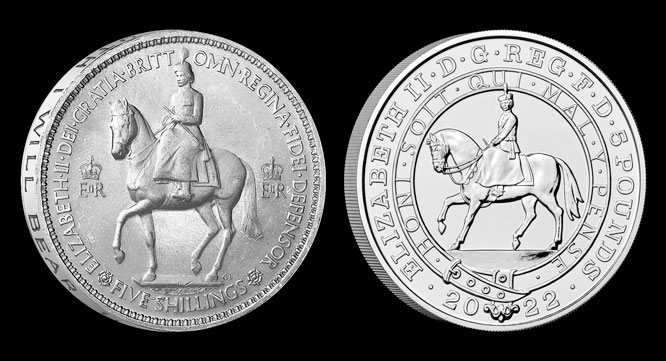
Both picture the Queen in regalia on horseback – bringing together the majesty of office with her greatest love – horses. Surely there can be no better way to remember Her Majesty than through these two great designs.
If you wish to be kept up to date about future In Memoriam and King Charles III commemoratives, you can sign up below.
We will only contact you about In Memoriam and King Charles III commemoratives and you can unsubscribe at any time. Privacy policy.
Prince Philip (1921 – 2021) – a Life in Coins
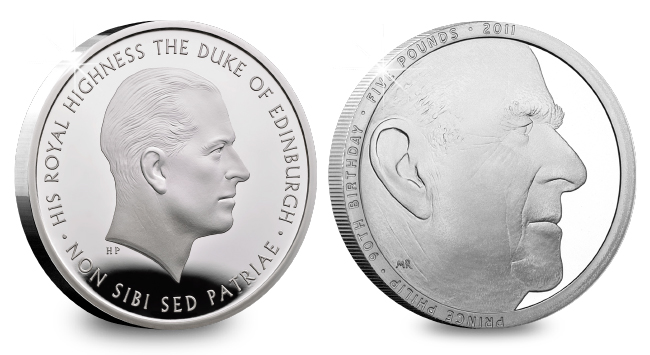
Over the coming days and weeks much will be written about Prince Philip. The dashing naval officer who married a Princess and has since provided steadfast support to the Queen as Britain’s longest serving Consort. But few of the many obituaries will dwell deeply on his key involvement in Britain’s coinage.
First Job – new coin designs
A new monarch means many things – one is a new coinage. On 21 March 1952, just weeks after the Queen’s accession to the throne, Prince Philip attended his first meeting as President of the Royal Mint Advisory Committee on the design of coins, medals, seals and decorations (RMAC); a role that he would hold for the next 47 years, until his retirement in 1999.
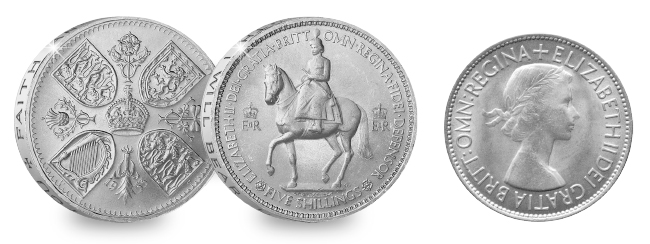
A keen artist himself, the Prince’s first job was to oversee the selection of the Queen’s portrait to ordain her new coins. An uncrowned Queen was chosen from a field of seventeen designs, giving Nottingham born sculptor, Mary Gillick, the honour of creating the most seen portrait of the new Queen. Equally importantly, the young Prince oversaw the design of the most important coin of the moment – the Coronation Crown, featuring Gilbert Ledward’s Queen on horseback on the obverse and Edgar Fuller’s reverse design containing the Coats of Arms of the constituent nations of the United Kingdom.
The UK’s biggest ever currency change
Gillick’s design remained on pre-decimal coinage until 1970, when Prince Philip was involved in another huge coinage milestone – the introduction of decimalisation. The process required a complete redesign of Britain’s coinage as well as an updated effigy of Her Majesty, designed to help the new denominations stand out. The RMAC selected Royal Academician Arnold Machin to sculpt the Queen, this time wearing a tiara. However, it was the reverse coin designs that were perhaps more significant.
A “monstrous piece of metal”
Under Prince Philip’s presidency, the RMAC started to work in top secret on designs as early as 1962, before there was any official government announcement confirming decimalisation. The final designs were created by Christopher Ironside and featured heraldic elements of the United Kingdom. But it was the new 50p coin – introduced to replace the 10/- note – that caused the greatest stir, with its unique heptagonal (7-sided) shape. Now Britain’s most popular coin with collectors, that was certainly not the case on its launch with one newspaper calling it a “monstrous piece of metal” and a retired colonel even starting Anti-Heptagonist movement.
In the 28 years that followed Decimalisation, Prince Philip guided the RMAC through two more effigies, Raphael Maklouf (1985 – 1997) and Ian Rank-Broadly (1998 – 2015), as well as the launch of 20p, £1 and £2 coins into circulation and numerous commemorative issues.
The five UK Coins that feature Prince Philip
Of course, Prince Philip has also featured on UK coins himself. The 1972 Crown issued to mark his Silver Wedding Anniversary was an understated affair. However, in 1997, the Queen and Duke of Edinburgh celebrated their Golden Wedding Anniversary, and Prince Philip featured on a UK coin for the very first time as part of a conjoined effigy on the obverse of the commemorative £5 coin. 2007 saw a similar conjoined portrait before the recent 2017 Platinum Wedding Anniversary design, which featured the Queen and Duke of Edinburgh on horseback in what can only been seen as a nod to the original 1953 Coronation Crown as well as a third conjoined portrait.
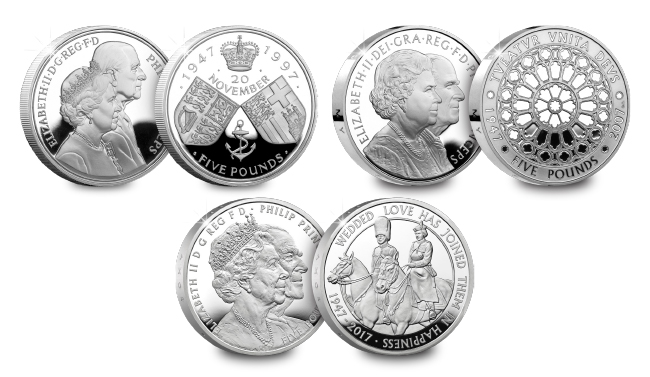
Yet it was in 2011 that Prince Philip was finally granted the greatest privilege – his own £5 Coin to celebrate his 90th Birthday – a splendid close up portrait of the Duke by Mark Richards FRBS. This was followed in 2017, with a design of the young Prince Philip by Humphrey Paget to mark Prince Philip stepping down from public duties after 70 years of service. We will remember Prince Philip for many things – but among them, spare some room for the man who has had more influence over the nation’s coins than any other. Surely the nation will do just that with a final memorial £5 Coin, in the same way we paid tribute to Princess Diana and HM Queen Mother.
Click here to view a number of new and previously issued numismatic and philatelic tributes to HRH Prince Philip, Duke of Edinburgh.
Relive the adventures of the Famous Five…

I can still remember crawling under my bed sheets as a child at night armed with a torch, and reading, fascinated, about the adventures of Julian, Dick, Anne, George and Timmy – the Famous Five – as they set off in their rowing boat to explore Kirrin Island and uncover shipwrecked gold, stumbling into all sorts of hijinks and thwarting crime in the process.
I still have that copy of the Famous Five’s first adventure, Five on a Treasure Island – now passed on to my children and, I hope, one day to my grandchildren.
But for me – and I’m sure for the many Famous Five lovers across the world – the joy of the “Five” novels is more than just the story.
Part of it is, of course, the beauty of the illustrations bringing the words to life. But it’s also the classic design of the books’ front covers, instantly recognisable and perfectly sized for a child’s hands. Books that are cherished as collectable in their own right.
And that’s why I have been so excited over the last few months to be able to work personally on an exclusive and highly collectable representation of Five on a Treasure Island. Something I’m confident will be passed from children to grandchildren in years to come, just like my battered family copy of the Famous Five.
Authenticity, heritage and limited edition
That’s because, for the very first time, the actual book fronts of the Famous Five novels are being faithfully reproduced on a series of Limited Edition Silver-Plated Ingots.
As you can see from the enclosed photos above and below, the first Ingot is a perfect limited edition recreation of the Five on a Treasure Island book cover, including the original coloured illustration that you, I, and many generations of children have grown up to love.
Throughout the process, authenticity and heritage have been paramount. And that’s still the case when you turn your Five on a Treasure Island Ingot over. As you do so, you reveal the words: “There was something else out on the sea by the rocks – something dark that seemed to lurch out of the waves… What could it be?” – the very text from one of the book’s most dramatic scenes.
Importantly, each Ingot has been struck to the very highest standards. The ingots themselves have been specially created to match the exact proportions of the original book and are finished with fine silver-plate.
Your invitation to SAVE £10.00 when you order today
Today, I would like to personally invite you to own the Five on a Treasure Island Silver-Plated Ingot for JUST £9.99 – an exclusive SAVING for you of £10.00.
Since it was first published in 1942, over 100 million copies of the Famous Five series have been sold. Today, two million copies of the books are still sold each year! And that’s when you realise where the collectible significance of this newly released Silver-Plated Ingot lies.
Only 9,995 ingots have been authorised.
Almost certainly,that’s far from enough for all the Famous Five lovers in Britain, let alone the rest of the world.


